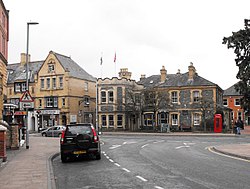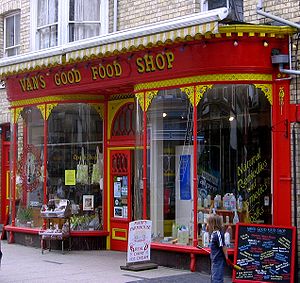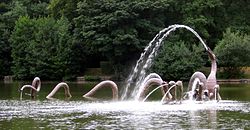Llandrindod Wells: Difference between revisions
Created page with '{{Infobox town |name=Llandrindod Wells |welsh=Llandrindod |county=Radnorshire |picture=Llandrindod Wells-Junction of South Crescent with Temple Street.jpg |picture caption=Juncti…' |
No edit summary |
||
| (2 intermediate revisions by 2 users not shown) | |||
| Line 23: | Line 23: | ||
During the mid-18th century the 'healing qualities' of the local spring waters attracted visitors to the area resulting in an economic boom with the building of a 'splendid' hotel at Llandrindod Hall. A period of relative decline during the late 18th and early 19th centuries was reversed with the construction of the Heart of Wales Line making Llandrindod accessible from the Midlands and North West of England, and South Wales. Enclosure of the common in 1862 enabled expansion of the town with the construction of new streets, hotels, shops and houses. | During the mid-18th century the 'healing qualities' of the local spring waters attracted visitors to the area resulting in an economic boom with the building of a 'splendid' hotel at Llandrindod Hall. A period of relative decline during the late 18th and early 19th centuries was reversed with the construction of the Heart of Wales Line making Llandrindod accessible from the Midlands and North West of England, and South Wales. Enclosure of the common in 1862 enabled expansion of the town with the construction of new streets, hotels, shops and houses. | ||
During the 'season' between May and mid-September visitors would take the waters at the pump rooms at the Rock Park and Pump House Hotel, entertained by orchestras. Shops — including the Central Wales Emporium on the corner of Temple Street and Station Crescent — and hotels and boarding houses catered for the visitors. In the early 1870s the ornamental lake had been formed by draining marshland near the Pump House Hotel | During the 'season' between May and mid-September visitors would take the waters at the pump rooms at the Rock Park and Pump House Hotel, entertained by orchestras. Shops — including the Central Wales Emporium on the corner of Temple Street and Station Crescent — and hotels and boarding houses catered for the visitors. In the early 1870s the ornamental lake had been formed by draining marshland near the Pump House Hotel, and in 1893 a 9-hole golf course was opened on the common beside the lake. (This was later replaced by the present 18-hole course on the hills above the lake.) Horse races (and, later, air displays) were held on the Rock Ddole meadow beside the river. In 1893 the Archdeacon with responsibility for the area had Llandrindod old church<ref>[http://www.cpat.demon.co.uk/projects/longer/churches/radnor/16835.htm Clwyd-Powys Archaeological Trust - Radnorshire Churches Survey - Church of Holy Trinity , Llandrindod]</ref> and Cefnllys church<ref>[http://www.cpat.demon.co.uk/projects/longer/churches/radnor/16743.htm Clwyd-Powys Archaeological Trust - Radnorshire Churches Survey - Church of St Michael , Cefnllys<!-- Bot generated title -->]</ref> unroofed in order to persuade the congregations to attend the new church in the centre of the town. In 1895 both churches were restored. | ||
[[File:Llandrindod Wells wholefood shop.jpg|thumb|left|Llandrindod's Victorian shopping experience]] | [[File:Llandrindod Wells wholefood shop.jpg|thumb|left|Llandrindod's Victorian shopping experience]] | ||
| Line 46: | Line 46: | ||
The architecture of the town includes many buildings in ornate styles dating from the boom period of the Victorian and Edwardian eras including the Metropole and the Glen Usk hotels, the Albert Hall theatre and former county hall building adjacent to it. There are also buildings in the Art Deco style including two striking former garages, Pritchard's and the Automobile Palace. The latter was notable for a collection of antique bicycles owned by the proprietor, Tom Norton, which were displayed suspended from ceilings in the building. The building has in recent years been renovated and is now home to several small businesses and the National Cycle Collection, featuring some of the bicycles originally displayed in the garage.<ref>[http://www.cyclemuseum.org.uk/ Welsh National Cycle Museum]</ref> | The architecture of the town includes many buildings in ornate styles dating from the boom period of the Victorian and Edwardian eras including the Metropole and the Glen Usk hotels, the Albert Hall theatre and former county hall building adjacent to it. There are also buildings in the Art Deco style including two striking former garages, Pritchard's and the Automobile Palace. The latter was notable for a collection of antique bicycles owned by the proprietor, Tom Norton, which were displayed suspended from ceilings in the building. The building has in recent years been renovated and is now home to several small businesses and the National Cycle Collection, featuring some of the bicycles originally displayed in the garage.<ref>[http://www.cyclemuseum.org.uk/ Welsh National Cycle Museum]</ref> | ||
The largest of the city's hotels are the Metropole (with 120 bedrooms of 3 star standard, an indoor swimming pool and leisure centre), the Glen Usk and the Commodore. The Hotel Metropole's swimming pool used to be open-air and was open to the public when it was the only pool in the town, but a public pool is available now at the sports centre attached to the local comprehensive school. A hotel in the scenic Rock Park has not survived, and various cafes and restaurants have come and gone over the years leaving a handful of establishments currently operating. | The largest of the city's hotels are the Metropole (with 120 bedrooms of 3-star standard, an indoor swimming pool and leisure centre), the Glen Usk and the Commodore. The Hotel Metropole's swimming pool used to be open-air and was open to the public when it was the only pool in the town, but a public pool is available now at the sports centre attached to the local comprehensive school. A hotel in the scenic Rock Park has not survived, and various cafes and restaurants have come and gone over the years leaving a handful of establishments currently operating. | ||
[[File:Llandrindod Wells lake water sculpture.jpg|thumb|250px|left|Water-sculpture on the lake]] | [[File:Llandrindod Wells lake water sculpture.jpg|thumb|250px|left|Water-sculpture on the lake]] | ||
| Line 55: | Line 55: | ||
The town has international standard outdoor bowling greens dating from 1912 which hosts national and international events<ref name=BBC>[http://www.bbc.co.uk/wales/mid/sites/walks/pages/spa_walk.shtml BBC mid-Wales walks]</ref><ref>[http://www.llandrindod-bowling.co.uk/history.php History of Llandrindod Wells Bowling Club]</ref> and a newer indoor bowling centre.<ref>[http://www.radnorbowls.co.uk/ Radnorshire Indoor Bowling Centre]</ref> | The town has international standard outdoor bowling greens dating from 1912 which hosts national and international events<ref name=BBC>[http://www.bbc.co.uk/wales/mid/sites/walks/pages/spa_walk.shtml BBC mid-Wales walks]</ref><ref>[http://www.llandrindod-bowling.co.uk/history.php History of Llandrindod Wells Bowling Club]</ref> and a newer indoor bowling centre.<ref>[http://www.radnorbowls.co.uk/ Radnorshire Indoor Bowling Centre]</ref> | ||
Llandrindod also hosts the recently | Llandrindod also hosts the recently established Heart of Wales Walking Festival<ref>http://www.llandrindod.co.uk/walking/index.htm</ref> | ||
==Culture== | ==Culture== | ||
| Line 63: | Line 63: | ||
The town hosts annual Scrambler Bike Trials in June. | The town hosts annual Scrambler Bike Trials in June. | ||
Llandrindod Wells Victorian Festival, known locally as Victorian Week, at the end of August, brings many visitors to the town. Many locals and some visitors dress in Victorian, Edwardian or other antique costumes, and many of the town's shops and other high-street businesses dress their windows or otherwise join in the spirit of the event. The festival typically offers open-air and street theatre and music, a fairground, craft fair, historical re-enactment, entertainments at the Albert Hall and exhibitions of things old-time. <ref>[http://www.vicfest.co.uk/ Victorian Festival]</ref> | Llandrindod Wells Victorian Festival, known locally as Victorian Week, at the end of August, brings many visitors to the town. Many locals and some visitors dress in Victorian, Edwardian or other antique costumes, and many of the town's shops and other high-street businesses dress their windows or otherwise join in the spirit of the event. The festival typically offers open-air and street theatre and music, a fairground, craft fair, historical re-enactment, entertainments at the Albert Hall and exhibitions of things old-time.<ref>[http://www.vicfest.co.uk/ Victorian Festival]</ref> | ||
==Outside links== | ==Outside links== | ||
| Line 80: | Line 80: | ||
* Joel Williams, ''Voices of Llandrindod Wells'', Red Dragon, 2000, ISBN 1903610001 | * Joel Williams, ''Voices of Llandrindod Wells'', Red Dragon, 2000, ISBN 1903610001 | ||
* Chris Wilson, ''Around Llandrindod Wells'', The Chalford Publishing Company, 1995, ISBN 0752401912 | * Chris Wilson, ''Around Llandrindod Wells'', The Chalford Publishing Company, 1995, ISBN 0752401912 | ||
[[Category:Spa towns in the United Kingdom]] | |||
Latest revision as of 15:12, 29 May 2024
| Llandrindod Wells Welsh: Llandrindod | |
| Radnorshire | |
|---|---|
 Junction of South Crescent and Temple Street | |
| Location | |
| Grid reference: | SO055615 |
| Location: | 52°14’37"N, 3°23’8"W |
| Data | |
| Population: | 5,024 (2001) |
| Post town: | Llandrindod Wells |
| Postcode: | LD1 |
| Dialling code: | 01597 |
| Local Government | |
| Council: | Powys |
| Parliamentary constituency: |
Brecon & Radnorshire |
Llandrindod Wells is a town in Radnorshire. It was developed as a spa town in the 19th century, with a boom in the late 20th century as a centre of local government. Before the 1860s the site of the town was common land in Cefnllys parish.
The town is known locally as "Llandod".
Development of the town
During the mid-18th century the 'healing qualities' of the local spring waters attracted visitors to the area resulting in an economic boom with the building of a 'splendid' hotel at Llandrindod Hall. A period of relative decline during the late 18th and early 19th centuries was reversed with the construction of the Heart of Wales Line making Llandrindod accessible from the Midlands and North West of England, and South Wales. Enclosure of the common in 1862 enabled expansion of the town with the construction of new streets, hotels, shops and houses.
During the 'season' between May and mid-September visitors would take the waters at the pump rooms at the Rock Park and Pump House Hotel, entertained by orchestras. Shops — including the Central Wales Emporium on the corner of Temple Street and Station Crescent — and hotels and boarding houses catered for the visitors. In the early 1870s the ornamental lake had been formed by draining marshland near the Pump House Hotel, and in 1893 a 9-hole golf course was opened on the common beside the lake. (This was later replaced by the present 18-hole course on the hills above the lake.) Horse races (and, later, air displays) were held on the Rock Ddole meadow beside the river. In 1893 the Archdeacon with responsibility for the area had Llandrindod old church[1] and Cefnllys church[2] unroofed in order to persuade the congregations to attend the new church in the centre of the town. In 1895 both churches were restored.

The town's boom continued until the First World War during which time soldiers on training courses were billeted in hotels and boarding houses, and refugees and wounded soldiers were accommodated in the town. The Great Depression of the late-1920s and 1930s led to many hotels and boarding houses being turned into private homes and flats. During the Second World War the town was again used for military hospitals and billets, followed by a slump in the post-war years.[3] The Beeching Axe in the mid-1960s closed the Mid-Wales line and with it Llandrindod's connection from nearby Builth Wells direct to Cardiff in the south and to North and West Wales. The town does however retain connections to Swansea and Shrewsbury by way of its station on the Heart of Wales Line.
During the 1970s the area became popular with hippies many of whom settled permanently in the area. In Llandrindod a hippy wholefood shop and café was established. At the time this was viewed with curiosity and even suspicion by local residents, some of whom harboured suspicions about the unfamiliar herbs sold in the shop. The shop's practice of asking customers to return paper bags for re-use in packaging food was also unfamiliar. In time, however, the shop became established and is now an accepted part of the local community, as well a being a successful business wholesaling to other outlets around Wales.
The reorganisation of local government in 1974 created a big council covering the Cambrian Mountains and which chose Llandrindod as its seat. This brought an influx of people employed by the new bureaucracies, on salaries determined by national pay scales. With the relatively low cost of living in the area this resulted in a boom in the town's economy as the newcomers spent their money on housing and entertainment.
In more recent years the economy has again flagged. Significant local industries, the town's carpet and stationery factories, closed, and many shops likewise. As in many such areas there are now many charity shops occupying premises once used by for-profit enterprises. An open-air market is held once a week which brings many visitors into the town, and supermarkets have established with more planned.
Features

The architecture of the town includes many buildings in ornate styles dating from the boom period of the Victorian and Edwardian eras including the Metropole and the Glen Usk hotels, the Albert Hall theatre and former county hall building adjacent to it. There are also buildings in the Art Deco style including two striking former garages, Pritchard's and the Automobile Palace. The latter was notable for a collection of antique bicycles owned by the proprietor, Tom Norton, which were displayed suspended from ceilings in the building. The building has in recent years been renovated and is now home to several small businesses and the National Cycle Collection, featuring some of the bicycles originally displayed in the garage.[4]
The largest of the city's hotels are the Metropole (with 120 bedrooms of 3-star standard, an indoor swimming pool and leisure centre), the Glen Usk and the Commodore. The Hotel Metropole's swimming pool used to be open-air and was open to the public when it was the only pool in the town, but a public pool is available now at the sports centre attached to the local comprehensive school. A hotel in the scenic Rock Park has not survived, and various cafes and restaurants have come and gone over the years leaving a handful of establishments currently operating.

The large man-made lake is popular for fishing and, in recent years, model boating. In the centre of the lake is a striking sculpture of a water serpent and leaping carp, the scales of which are made of thousands of copper plates initialled by local people and visitors during construction of the work. Beside the lake a distinctive tree-trunk sculpture known as the Llandoddie has been carved "to create a corporate image ... to attract tourists and provide the town with a strong identity for people to rally round" [5]
An 18-hole golf course, established in 1905,[6] features challenging topology and sweeping views over the lake, the town and surrounding countryside.
The town has international standard outdoor bowling greens dating from 1912 which hosts national and international events[7][8] and a newer indoor bowling centre.[9]
Llandrindod also hosts the recently established Heart of Wales Walking Festival[10]
Culture

The amateur Drama Festival, held in May at the Albert Hall, attracts theatrical groups from all over the British Isles and achieves high standards of performances.
The town hosts annual Scrambler Bike Trials in June.
Llandrindod Wells Victorian Festival, known locally as Victorian Week, at the end of August, brings many visitors to the town. Many locals and some visitors dress in Victorian, Edwardian or other antique costumes, and many of the town's shops and other high-street businesses dress their windows or otherwise join in the spirit of the event. The festival typically offers open-air and street theatre and music, a fairground, craft fair, historical re-enactment, entertainments at the Albert Hall and exhibitions of things old-time.[11]
Outside links
- Welcome to Llandrindod Wells – introduction, history and architecture
- Llandrindod Wells & District Chamber of Trade
References
- ↑ Clwyd-Powys Archaeological Trust - Radnorshire Churches Survey - Church of Holy Trinity , Llandrindod
- ↑ Clwyd-Powys Archaeological Trust - Radnorshire Churches Survey - Church of St Michael , Cefnllys
- ↑ Wilson, Chris. Around Llandrindod Wells. The Chalford Publishing Company Limited. ISBN 0-7524-0191-2.
- ↑ Welsh National Cycle Museum
- ↑ Llandoddie in a BBC article.
- ↑ History of Llandrindod Wells Golf Club (from club's website)
- ↑ BBC mid-Wales walks
- ↑ History of Llandrindod Wells Bowling Club
- ↑ Radnorshire Indoor Bowling Centre
- ↑ http://www.llandrindod.co.uk/walking/index.htm
- ↑ Victorian Festival
Books
- Jane Griffiths, Walking Around Llandrindod Wells: Historic Spa Town, Kittiwake Press, 2007, ISBN 1902302516
- Olivia Harries, Llandrindod Wells in Old Postcards, C Davies, 1986, ISBN 0715406639
- Reginald Campbell Burn Oliver, Bridging a century: [the Hotel Metropole, Llandrindod Wells, 1872-1972], a century of growth in the story of Llandrindod Wells, Radnorshire, Sayce Brothers Printers, 1972, ISBN 0950233706
- Reginald Campbell Burn Oliver, The centenary of the Church of the Holy Trinity, Llandrindod Wells, 1871-1971, R.C.B. Oliver, 1971, ISBN 0950148016
- Bruce Osborne, Llandrindod Wells, New Millennium Spa Heritage Series, 1999, ISBN 1873614063
- Joel Williams, Voices of Llandrindod Wells, Red Dragon, 2000, ISBN 1903610001
- Chris Wilson, Around Llandrindod Wells, The Chalford Publishing Company, 1995, ISBN 0752401912